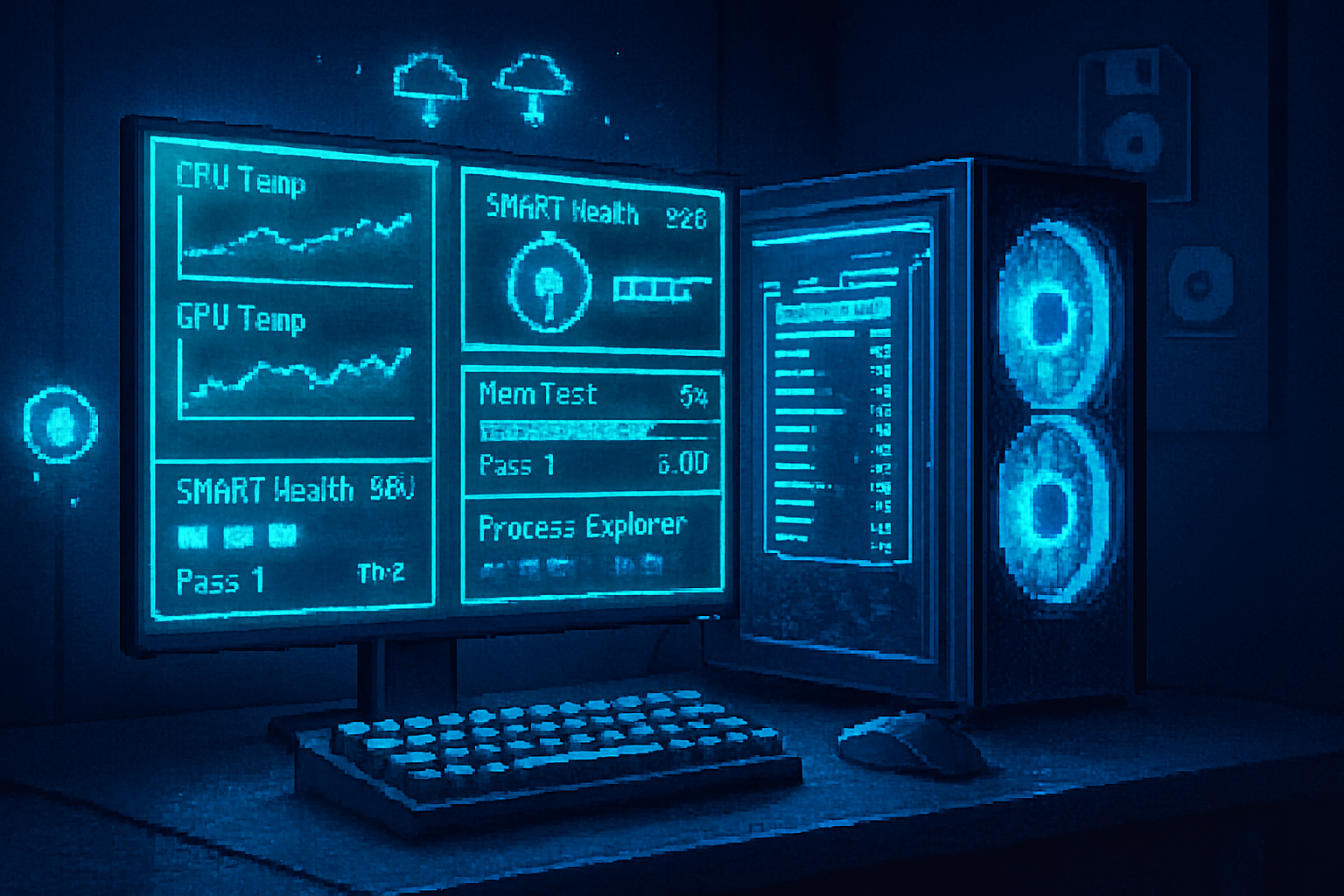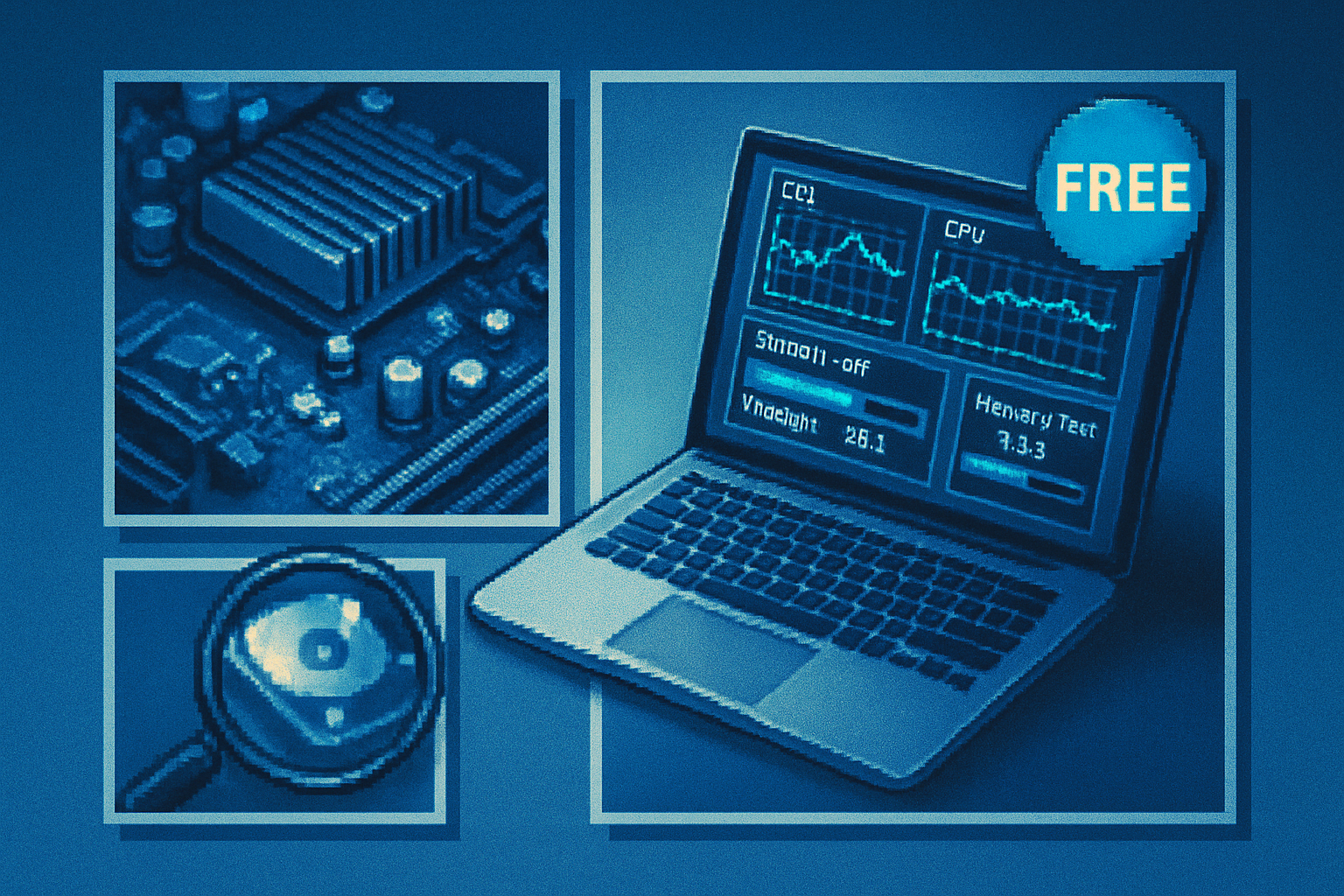· 6 min read
The Evolution of Free PC Diagnostic Tools: From Basic to Advanced
A deep dive into how free PC diagnostic tools grew from simple utilities into sophisticated, AI-ready toolkits - tracing key innovations, landmark tools, and what the future holds for diagnostics, preventive maintenance, and troubleshooting.

Introduction
PC diagnostics started as a toolbox of simple checks and has grown into a diverse ecosystem of feature-rich, free utilities that help hobbyists, IT pros, and everyday users keep systems healthy. This article traces that evolution, highlights pivotal tools and innovations, and predicts where free diagnostics are headed.
Early days: simple, single-purpose utilities (1990s–2000s)
In the PC’s early years, diagnostics were often single-purpose programs or built into firmware. Typical checks included:
- Memory tests that wrote patterns to RAM to find faults.
- Disk utilities that ran surface scans for bad sectors.
- CPU ID utilities to report processor model and clock.
Notable early and foundational free tools:
- MemTest86 - one of the first widely used standalone memory testers that boots from removable media to test RAM outside the OS environment (MemTest86).
- CPU-Z - a lightweight system profiler reporting CPU, cache, mainboard, and memory details (CPU-Z).
- Early SMART-aware disk utilities and surface scanners that relied on mechanical drive health checks (see S.M.A.R.T. technology overview) (S.M.A.R.T.).
These tools were small, focused, and often ran from boot media - essential for diagnosing systems that could not load an operating system.
The rise of third-party suites and monitoring (2000s–2010s)
As hardware complexity rose (multi-core CPUs, GPUs, multi-channel memory, RAID arrays, SATA/USB), diagnostics evolved to match. Developers built richer GUIs, real-time monitoring, and extended functionality:
- Sysinternals suite - Microsoft’s acquisition and continued development of Sysinternals delivered powerful free utilities like Process Explorer, Autoruns, Process Monitor, and more, bringing advanced runtime inspection to users and admins (Sysinternals).
- HWiNFO, HWMonitor, and Speccy - tools that report voltages, temperatures, fan speeds, and comprehensive component metadata (e.g., HWiNFO).
- CrystalDiskInfo / CrystalDiskMark - free utilities focused on SMART status and benchmarking storage devices (CrystalDiskInfo).
- Open-source projects (Open Hardware Monitor, LibreHardwareMonitor) brought transparency and community-driven development to hardware telemetry (LibreHardwareMonitor).
Key innovations in this era:
- Real-time telemetry - continuous temperature/voltage/fan monitoring.
- SMART integration - interpreting drive self-test data to predict failures.
- Bootable diagnostic images - complete offline toolkits (memtests, disk tools, firmware utilities).
- Malware- and rootkit-aware process inspection via low-level hooks.
Windows and OEM diagnostic improvements
Microsoft and OEMs improved built-in diagnostics, reducing dependency on third-party tools for some tasks:
- Windows Reliability Monitor and Resource Monitor give users long-term stability data and resource usage timelines.
- Windows Memory Diagnostic provides a built-in, bootable RAM tester.
- OEMs added UEFI/BIOS-level hardware diagnostics that run independently of the OS.
See Microsoft docs for built-in Sysinternals and reliability features (Windows Reliability Monitor).
Modern era: integrated, automated, and cloud-aware diagnostics (2015–present)
The last decade introduced a step-change: diagnostics became integrated, proactive, and more user-friendly.
Trends and features that define modern free tools:
- Unified dashboards - single-pane views that combine CPU, GPU, storage, network, and power telemetry.
- SMART and NVMe-aware diagnostics - tools evolved to handle SSD-specific failure modes (wear leveling, power-cycle count, program/erase cycles).
- Live system introspection - advanced process monitors, network activity tracing, and kernel-level event capture (e.g., Process Monitor from Sysinternals).
- Remote and cloud-assisted diagnostics - consumer tools increasingly offer cloud-based logs, sharing links, and remote troubleshooting flows.
- Predictive alerts - simple forms of predictive failure warnings using SMART thresholds, temperature trends, and event correlation.
- Cross-platform and portable tooling - bootable images, portable apps, and lightweight installers made diagnostics more accessible.
Examples of modern free tools and ecosystems:
- HWiNFO and HWMonitor - favored by enthusiasts for deep telemetry (HWiNFO).
- CrystalDiskInfo and related utilities for storage analytics (CrystalDiskInfo).
- LibreHardwareMonitor/Open-source projects offering extensibility and scripting (LibreHardwareMonitor).
- Sysinternals continues to provide free, advanced runtime tools for process, file, and registry inspection (Sysinternals).
Why “free” matters
Free diagnostic tools lower the barrier for detection and repair. They enable:
- Home users to identify failing drives before data loss.
- Enthusiasts to safely overclock and validate stability.
- Admins to triage problems without expensive licenses.
- Educators to teach hardware/software diagnostics affordably.
Limits still exist: free tools sometimes lack advanced automation, warranty-integrated telemetry, or enterprise-grade remote management found in paid RMM (Remote Monitoring and Management) suites.
Case studies: Diagnostics that saved systems
- Prevented drive failure - a user notices increasing reallocated sector counts in CrystalDiskInfo, backs up data, and replaces the drive before catastrophic failure.
- Root cause analysis - Process Explorer and Process Monitor reveal a driver repeatedly crashing, guiding the user to a patched driver.
- Memory stability - MemTest86 catches intermittent RAM errors that Windows Memory Diagnostic missed, allowing for a targeted RAM module replacement.
Practical guidance: choosing and using free diagnostic tools
- Start with built-ins - check Windows reliability logs, Resource Monitor, and Windows Memory Diagnostic for a baseline.
- Use a layered approach:
- Hardware telemetry - HWiNFO / LibreHardwareMonitor for temperatures and voltages.
- Storage health - CrystalDiskInfo for SMART, CrystalDiskMark for performance checks.
- Memory - MemTest86 bootable image for thorough RAM testing.
- Runtime issues - Sysinternals Process Explorer / Process Monitor for process/thread-level investigation.
- Work offline when possible - bootable tools help when the OS is unstable.
- Back up before tinkering - diagnostics can identify bad hardware, but any repair or swap should start with a safe backup.
- Keep tools up to date - hardware evolves (NVMe, new CPU features), and tool updates add compatibility and new checks.
The next frontier: what to expect in diagnostics (2025 and beyond)
AI-assisted triage and repair
- Machine learning models will analyze telemetry and logs across millions of endpoints to provide automated root-cause suggestions and step-by-step repair plans.
- Expect conversational diagnostics (chat-driven troubleshooting) that guide non-technical users.
Predictive maintenance at consumer scale
- Predictive algorithms will move beyond simple SMART thresholds to evaluate wear patterns on SSDs, capacitor degradation on motherboards, and fan/motor failure patterns, offering earlier and more accurate warnings.
Deeper firmware and hardware-level access
- Tools will expand firmware analysis (BIOS/UEFI, SSD firmware) to detect corruption, performance regressions, and supply-chain anomalies.
- Standardized telemetry APIs (e.g., Redfish in servers) may influence consumer diagnostics through standardized device reporting.
Cross-device and cloud-unified diagnostics
- A single pane for PCs, phones, and IoT devices with correlated incident timelines and shared user contexts.
Privacy-first, decentralized analytics
- To maintain user privacy, diagnostics will increasingly support edge processing of telemetry, sending only anonymized insights to cloud services when necessary.
Integration with OS and OEM ecosystems
- Expect better OS-level hooks for self-healing, automatic driver rollbacks, and warranty-aware diagnostic flows with OEM support.
Challenges and considerations
- False positives and alert fatigue - more granular telemetry risks overwhelming users unless properly filtered and contextualized.
- Security and privacy - telemetry can expose sensitive behavior; transparent opt-ins and local-first processing will be essential.
- Hardware diversity - as device types proliferate, maintaining accurate checks across countless configurations remains hard for free tooling.
Conclusion
Free PC diagnostic tools have come a long way - from humble bootable memory checks and surface scanners to real-time telemetry dashboards, SMART-aware analytics, and cloud-assisted troubleshooting. The future promises even smarter, more proactive, and more integrated diagnostics, but with that comes the need to balance accuracy, privacy, and user experience. For consumers and IT pros alike, free tools will continue to play a critical role: empowering detection, enabling preventive action, and democratizing technical expertise.
References and further reading
- MemTest86 - https://www.memtest86.com/
- CPU-Z - https://www.cpuid.com/softwares/cpu-z.html
- Sysinternals (Microsoft) - https://learn.microsoft.com/en-us/sysinternals/
- CrystalDiskInfo - https://crystalmark.info/en/software/crystaldiskinfo/
- HWiNFO - https://www.hwinfo.com/
- LibreHardwareMonitor - https://github.com/LibreHardwareMonitor/LibreHardwareMonitor
- S.M.A.R.T. overview - https://en.wikipedia.org/wiki/S.M.A.R.T.
- Windows Reliability Monitor - https://support.microsoft.com/


